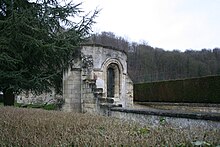Prémontré Abbey
The Prémontré Abbey in Prémontré west of Laon ( Aisne Department , France) was the motherhouse of the Premonstratensian Order .
history
Norbert von Xanten founded the abbey in 1120 on wasteland that had previously belonged to the Saint-Vincent Abbey in Laon (the monks of Saint-Vincent had tried in vain to cultivate the land) and later belonged to a bishop of Laon . In the deed of gift, the place was named Præmonstratus or pratum monstratum ( Pré-montré or Prémontré ). This may refer to a clearing in the forest, but was possibly also based on the expression locus praemonstratus , "(by God) shown place", as it appears in the biography of Gottfried von Kappenberg , one of Norbert's first pupils (1127): "Venit ad locum vere juxta nomen suum, a domino premonstratum, electum et prædestinatum." An old tradition reports that the Bishop of Laon and Norbert von Xanten visited Prémontré in mid-January and that Bishop Norbert wore the white habit on January 25th, the feast of the conversion of Paul of Tarsus ( Damascus experience ).
After the Council of Liege ended in 1131, Pope Innocent II and Norbert came to Laon to see Bishop Bartholomew . Together they visited the Prémontré Abbey, where around 500 priests, clerics and lay brothers were already living under the direction of Abbot Hugos von Fosses . In the General Chapter of 1141 it was then decided to relocate the women's monastery (it was originally the practice of the Premonstratensians to build double monasteries ) so that it was at least a mile away from the men's monastery. Abbot Hugo died on February 10, 1161, and was succeeded by Philip, previously Abbot of Belval in the Ardennes . Another important abbot in the history of Prémontré was Abbot John II, who founded the College of the Premonstratensians at the Sorbonne in 1252 .
After the death of the 43rd Abbot General of Prémontré, Virgilius, Cardinal Francis of Pisa succeeded in having himself appointed as Commendatar Abbot of Prémontré and thus securing the abbey and its entire income from 1535. His successor was Cardinal Ippolito II. D'Este († 1572), papal legate in France. Taiée calls these two cardinals somewhat polemically "les fléaux de Prémontré" ("the scourges of Prémontré"). After Estes death there was a free abbot election, in which Jean Des Pruets , theologian at the Sorbonne, was elected; this election was on December 14, 1572 by Pope Gregory XIII. approved. Des Pruets succeeded in reorganizing and consolidating the financial situation in Prémontré and other houses of the order. He died on May 15, 1596. With his successors, Longpré and Gosset, Prémontré received more capable abbots. Their successor was finally Cardinal Richelieu , again as Commendatar Abbot.
The last Abbot General, l'Ecuy, was elected in 1781. During the French Revolution , the abbey was dissolved, its property confiscated and the buildings sold to a certain Cagnon, who had some parts demolished and sold the stones. After a few more changes of ownership, the abbey finally came into the hands of Paul-Armand de Cardon de Garsignies , Bishop of Soissons , whose successor sold it to the Aisne department, which in turn turned the abbey into a psychiatric institution .
building
Hardly anything has been preserved from the medieval abbey. Only three buildings from the 17th and 18th centuries are still standing, one of which is used as the church consecrated to Norbert von Xanten. The remaining part continues to serve as a psychiatric hospital.
See also
Individual evidence
Web links
Coordinates: 49 ° 32 '50 " N , 3 ° 24' 38" E

